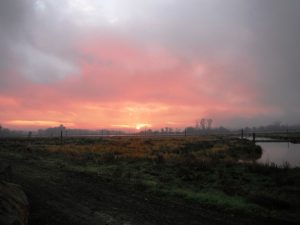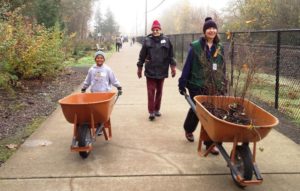Tag: nature
Tree walks & tree talks for you
It’s the 50th anniversary of Earth Day this year. Friends of Trees was planning to celebrate in our usual fashion: Planting trees. Together. But, like everyone, our plans changed.
We would, of course, prefer to be outside with you. But since we can’t we have some really special virtual tree treats for you.
Since trees and nature can be so comforting, the Friends of Trees staff contributed to Earth Day with some homemade tree talk videos; we’re hoping these will tide you over until we can plant trees with you again. Below is a selection of our work, you can find the entire playlist here (we’ll be adding more, so check back!).
Welcoming the return of the sun … with trees

“Each Friends of Trees planting event is a series of moments, whether it’s somebody seeing a lizard, or a kid planting their first tree, or people who just happened to be walking by pitching in to help. One of the best moments is at the end of the day when everyone has a big smile on their face because they’ve really accomplished something: they planted trees.” Matt, Friends of Trees volunteer
Did you know that the oldest tree in the world is 5,062 years old? It’s a Pinus longaeva (Great Basin bristlecone pine) and it’s in California.
While we can’t claim with certainty that Friends of Trees just planted the newest tree in the world, it is possible, at least for a moment on any given Saturday, October-April, that we did indeed just plant the newest tree in the world. That’s another Friends of Trees moment: adding a tree–to our region, to our planet. And there are more than 50,000 moments like that every tree planting season.
As we celebrate the Winter Solstice and welcome the return of the sun we’re thinking about the various ways the shortest day of the year is celebrated, especially, of course, the celebrations that include trees. We’ve learned that some Winter Solstice celebrations include specific trees that have specific meanings; for instance, for some observants evergreens symbolize continuity of life, and oak trees symbolize endurance, strength, protection, and good luck.
We love this. Here’s how Friends of Trees interprets these special meanings of evergreens and oaks:
Continuity of life: trees provide oxygen!
Endurance, strength: trees can live to be hundreds, thousands of years old.
Protection: trees clean our air and water and help make us healthy.
Good luck: to me, it’s clear: the more trees we have, the luckier we are.
A recent paper by U.S. Forest Service scientists* reported that metropolitan areas in the U.S. are losing more than 30 million trees each year. This is tragic, but thanks to Friends of Trees’ friends and supporters, we’re not fretting, we’re taking action and tackling this loss, together, one moment at a time, one tree at a time – at more than 50,000 moments, and 50,000 trees, every year. You can help us take positive action through making a donation to Friends of Trees today! Your support helps grow our urban canopy, restore sensitive natural areas, and helps build community through planting trees – together.
Happy Solstice to you and yours, we look forward to longer days, the return of the sun, and more trees – join us!
Learn how trees help make us healthy
 Do you know how increased exposure to nature creates countless health benefits?
Do you know how increased exposure to nature creates countless health benefits?
Join us for a free Trees & Health event–in Portland, Salem and Eugene
Trees benefit people, creatures and the planet in ways too numerous to list here. We know that trees combat climate change, clean our air and water, create habitat, grow food … Trees do so much that it’s no surprise that trees improve our health, too—but it’s only relatively recently that we’ve learned just how much trees contribute to human health. Friends of Trees is now using that knowledge to implement programming specific to trees and health.
Thanks to a 2016 funding award from Metro, Friends of Trees has expanded our community tree-plantings to include Portland’s Northwest Industrial District, focusing on projects to directly impact human health. Our goal is adding green infrastructure to this area that has an abundance of concrete and a dearth of green. These plantings will also forge a stronger connection between the Industrial District and Forest Park, which is so close yet so disconnected from this part of town; adding trees in the industrial section contributes to a green corridor, channeling the benefits of the park to the industrial district.
How do trees make us healthy? Patients in hospitals heal more quickly if they have a view of trees and nature; people are more likely to get out and walk and run through tree-lined communities; babies in tree-lined neighborhoods are more likely to have a healthy birth weight; exposure to greenspaces can reduce blood pressure and stress levels; views of natural settings have been found to reduce crime and aggression … to list just a few.
Yes, the trees we plant here will improve our health, but so will the way we plant those trees. Our community tree-planting program is implemented with thousands of volunteers, many of whom have never volunteered before. And guess what? Volunteering is good for your health, too! Volunteering makes us happy, contributes to more satisfied employees, decreases the risk of depression, reduces stress levels, and more!
And to help these trees grow and thrive, Friends of Trees will water, mulch and prune these new trees for their first two years in the ground. This is slow and steady work, and we are excited to continue growing this program over time.
There’s another component to this project: Scientists. Presentations by experts are a part of our Trees and Health work. It’s an exciting time, with new research coming out regularly, and we look forward to sharing this important information with our community.
Learn more about trees and health.
JOIN US FOR A FREE TREES & HEALTH EVENT
Guest lecturer Dr. Kathy Wolf of the University of Washington explores how nearby nature improves environmental, social, and economic conditions in cities
- Portland, March 1, 6-7:30 p.m.
- Salem, March 2, 6-7:30 p.m.
- Eugene, March 3, 5:30-7:00 p.m.
Location and registration information.
This is an excerpt from our February Treemail, read the entire issue here.
